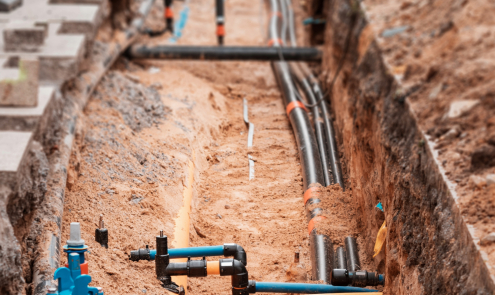A CLOSER LOOK AT PART L UPDATES
22 Mar 2022
Just before Christmas last year, government gifted a mandate which would see a 30% cut in carbon across all new residential buildings. The updates to Part L of the Building Regulations, which is to do with energy use, Part F for ventilation and the introduction of a new Part O for overheating will reportedly pave the way for a greener built environment. But do the updates go far enough?
Ellen Huelin, Associate Director at Whitecode Consulting takes a closer look.
Part L updates
We have been expecting the changes for some time. This is the biggest update to Part L of the Building Regulations since 2013, where we will see a 30% reduction in carbon in new homes. As highlighted in the updates to Part L, the reduction will be achieved through fabric improvements and carbon saving technologies, i.e., the addition of PV panels or air source heat pumps.
The announcements were set out in the Department for Levelling-Up, Housing and Communities (DLUHC)’s response published last month to a public consultation, which ran from January to April 2021 on the Future Buildings Standard. It details interim uplifts to Parts L and F of the Building Regulations and the introduction of Part O. Part L applies to all projects after 15 June 2022, except projects where a building notice has been given. The new regulations will apply to all projects regardless from 15 June 2023.
During the consultation an array of options was considered, but they decided to go for a higher uplift that’s not just based on building fabric but carbon saving technologies too. Taking a magnifying glass to the updates, the performance metrics for Part L 2021 include:
- Primary energy target
- CO2 emission target
- Fabric energy efficiency target (FEES – DFEE/TFEE)
- Minimum standards for fabric and fixed building services
In many ways the updates to Part L will prepare many companies for the change that will come when the Future Homes and Buildings Standard comes into force in 2025. It is in that sense an important stepping stone. These latest updates to Part L mean that residential buildings built from 2023 are more prepared for the 2025 change.
Furthermore, the focus on fabric-first approach and carbon saving technologies will therefore steadily remove dependency on gas boilers which are to be banned in new homes from 2025. Many GLA schemes that the likes of Whitecode Consulting work on are already installing heat pumps instead of gas boilers. The biggest challenge will be ensuring this change happens outside of London.
As well as a focus on carbon technologies, a tighter building fabric will need to be achieved in preparation for the Future Homes Standard. The focus here isn’t so much on walls or doors but windows, which lose around 18% of a house’s total heat. To provide a solution to this issue, there is a need for windows to have stronger U-values. We will, then, see triple glazing with a 0.8 U-value expected by 2025.
Closer inspection
Businesses would do well to start putting these changes into motion as there are new requirements that have to be met. As part of the change and to assure compliance, photographs will be required during the construction of properties to prove correct installation; all plots must be air tested; accredited construction details (ACDs) for thermal bridging will be scrapped; and plot specific approach to transitional arrangements.
Taking a closer look at the transitional arrangements is key, as there are details that must be considered. For Part L 2021 the site-wide approach for transitioning will change to a plot/building specific approach. Therefore plots/buildings that do not start within a year of the regulation’s application, even if on the same site, would need to be built to the latest standards.
New Part O
Another regulation that has been newly introduced is Part O for overheating. Here at Whitecode Consulting we have been performing overheating analysis for many years. Overheating can cause huge discomfort to homeowners and compromise their wellbeing. But, up until now it hasn’t ever been regulated. It is assuring, therefore, to see the introduction of Part O.
Previously, TM59 overheating assessments were performed in order to assure compliance with the London Plan. Whilst this rigorous assessment will still be a method of choice on some projects, as it can offer more design flexibility, Part O certainly offers a more simplified, formulaic method which will be desirable on projects.
It’s key to look closely at the changes Part O includes. Projects will not, for instance, be able to use internal blinds to comply. Blinds have been continually used in developments to prevent overheating. Now, with the new Part O, schemes will need to include other kinds of shading including external to comply. Whichever route is selected, Whitecode Consulting has the experience and expertise to help clients navigate their chosen path.
All in all, the updates to Part L, Part F and the introduction of Part O are highly welcomed. The updates to Part L in particular will go some way to preparing us for the Future Homes Standard in 2025. The changes, however, are severely overdue and could have gone further, as the reality is that the change has to be done now. Given that we are living in a climate emergency, will the industry be quicker to adopt the change? We’ll have to wait and see.
Part L updates
We have been expecting the changes for some time. This is the biggest update to Part L of the Building Regulations since 2013, where we will see a 30% reduction in carbon in new homes. As highlighted in the updates to Part L, the reduction will be achieved through fabric improvements and carbon saving technologies, i.e., the addition of PV panels or air source heat pumps.
The announcements were set out in the Department for Levelling-Up, Housing and Communities (DLUHC)’s response published last month to a public consultation, which ran from January to April 2021 on the Future Buildings Standard. It details interim uplifts to Parts L and F of the Building Regulations and the introduction of Part O. Part L applies to all projects after 15 June 2022, except projects where a building notice has been given. The new regulations will apply to all projects regardless from 15 June 2023.
During the consultation an array of options was considered, but they decided to go for a higher uplift that’s not just based on building fabric but carbon saving technologies too. Taking a magnifying glass to the updates, the performance metrics for Part L 2021 include:
- Primary energy target
- CO2 emission target
- Fabric energy efficiency target (FEES – DFEE/TFEE)
- Minimum standards for fabric and fixed building services
In many ways the updates to Part L will prepare many companies for the change that will come when the Future Homes and Buildings Standard comes into force in 2025. It is in that sense an important stepping stone. These latest updates to Part L mean that residential buildings built from 2023 are more prepared for the 2025 change.
Furthermore, the focus on fabric-first approach and carbon saving technologies will therefore steadily remove dependency on gas boilers which are to be banned in new homes from 2025. Many GLA schemes that the likes of Whitecode Consulting work on are already installing heat pumps instead of gas boilers. The biggest challenge will be ensuring this change happens outside of London.
As well as a focus on carbon technologies, a tighter building fabric will need to be achieved in preparation for the Future Homes Standard. The focus here isn’t so much on walls or doors but windows, which lose around 18% of a house’s total heat. To provide a solution to this issue, there is a need for windows to have stronger U-values. We will, then, see triple glazing with a 0.8 U-value expected by 2025.
Closer inspection
Businesses would do well to start putting these changes into motion as there are new requirements that have to be met. As part of the change and to assure compliance, photographs will be required during the construction of properties to prove correct installation; all plots must be air tested; accredited construction details (ACDs) for thermal bridging will be scrapped; and plot specific approach to transitional arrangements.
Taking a closer look at the transitional arrangements is key, as there are details that must be considered. For Part L 2021 the site-wide approach for transitioning will change to a plot/building specific approach. Therefore plots/buildings that do not start within a year of the regulation’s application, even if on the same site, would need to be built to the latest standards.
New Part O
Another regulation that has been newly introduced is Part O for overheating. Here at Whitecode Consulting we have been performing overheating analysis for many years. Overheating can cause huge discomfort to homeowners and compromise their wellbeing. But, up until now it hasn’t ever been regulated. It is assuring, therefore, to see the introduction of Part O.
Previously, TM59 overheating assessments were performed in order to assure compliance with the London Plan. Whilst this rigorous assessment will still be a method of choice on some projects, as it can offer more design flexibility, Part O certainly offers a more simplified, formulaic method which will be desirable on projects.
It’s key to look closely at the changes Part O includes. Projects will not, for instance, be able to use internal blinds to comply. Blinds have been continually used in developments to prevent overheating. Now, with the new Part O, schemes will need to include other kinds of shading including external to comply. Whichever route is selected, Whitecode Consulting has the experience and expertise to help clients navigate their chosen path.
All in all, the updates to Part L, Part F and the introduction of Part O are highly welcomed. The updates to Part L in particular will go some way to preparing us for the Future Homes Standard in 2025. The changes, however, are severely overdue and could have gone further, as the reality is that the change has to be done now. Given that we are living in a climate emergency, will the industry be quicker to adopt the change? We’ll have to wait and see.

WHITECODE CONSULTING GAINS HIGHLY...
As a company that prides itself on sustainability in design and exceeding – not just meeting – industry standards, Whitecode Consulting is delighted to announce it has gained the coveted Chartered Institution of Building Services...
Read More
Utilities consultants: helping to prevent...
Utilities consultants: providing the vital support every construction project needs
By Gary Akers, Head of Utilities at Whitecode Consulting
The UK’s cost of living crisis is adding significant financial challenges for everyone...
Read MoreLike to Know More? Let's Talk...







